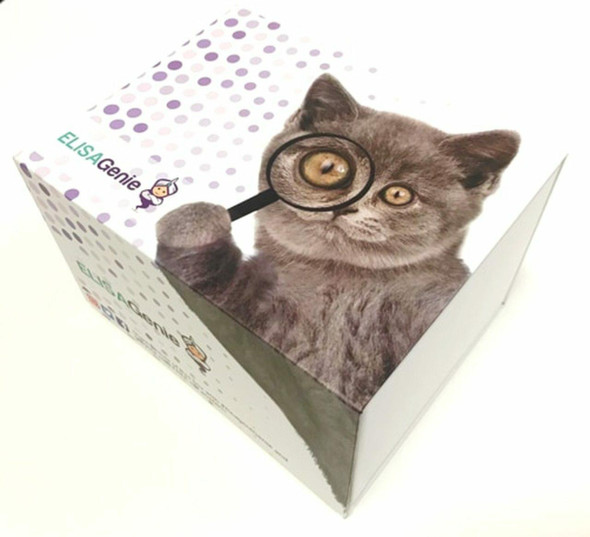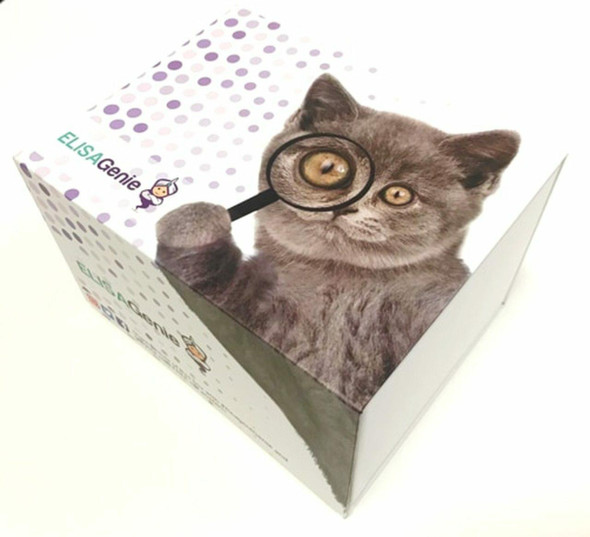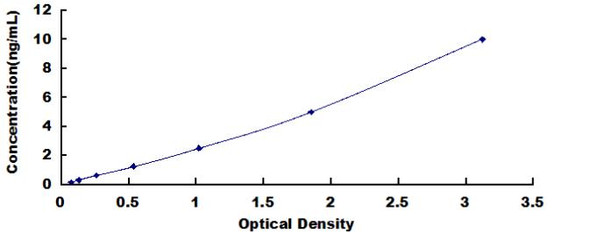Human Signal Transduction ELISA Kits
Human ADAM10 (A Disintegrin And Metalloprotease 10) CLIA Kit (HUES00196)
- SKU:
- HUES00196
- Product Type:
- ELISA Kit
- ELISA Type:
- CLIA Kit
- Size:
- 96 Assays
- Sensitivity:
- 9.38pg/mL
- Range:
- 15.63-1000pg/mL
- ELISA Type:
- Sandwich
- Synonyms:
- AD10, CD156c, CDw156, HsT18717, MADM, kuz, ADAM metallopeptidase domain 10
- Reactivity:
- Human
- Sample Type:
- Serum, plasma and other biological fluids
- Research Area:
- Signal Transduction
Description
| Assay type: | Sandwich |
| Format: | 96T |
| Assay time: | 4.5h |
| Reactivity: | Human |
| Detection method: | Chemiluminescence |
| Detection range: | 15.63-1000 pg/mL |
| Sensitivity: | 9.38 pg/mL |
| Sample volume: | 100µL |
| Sample type: | Serum, plasma and other biological fluids |
| Repeatability: | CV < 15% |
| Specificity: | This kit recognizes Human ADAM10 in samples. No significant cross-reactivity or interference between Human ADAM10 and analogues was observed. |
This kit uses Sandwich-CLIA as the method. The micro CLIA plate provided in this kit has been pre-coated with an antibody specific to Human ADAM10. Standards or samples are added to the appropriate micro CLIA plate wells and combined with the specific antibody. Then a biotinylated detection antibody specific for Human ADAM10 and Avidin-Horseradish Peroxidase (HRP) conjugate are added to each micro plate well successively and incubated. Free components are washed away. The substrate solution is added to each well. Only those wells that contain Human ADAM10, biotinylated detection antibody and Avidin-HRP conjugate will appear fluorescence. The Relative light unit (RLU) value is measured spectrophotometrically by the Chemiluminescence immunoassay analyzer. The RLU value is positively associated with the concentration of Human ADAM10. The concentration of Human ADAM10 in the samples can be calculated by comparing the RLU of the samples to the standard curve.
| UniProt Protein Function: | ADAM10: Cleaves the membrane-bound precursor of TNF-alpha at '76-Ala-|-Val-77' to its mature soluble form. Responsible for the proteolytical release of soluble JAM3 from endothelial cells surface. Responsible for the proteolytic release of several other cell-surface proteins, including heparin-binding epidermal growth- like factor, ephrin-A2 and for constitutive and regulated alpha- secretase cleavage of amyloid precursor protein (APP). Contributes to the normal cleavage of the cellular prion protein. Involved in the cleavage of the adhesion molecule L1 at the cell surface and in released membrane vesicles, suggesting a vesicle-based protease activity. Controls also the proteolytic processing of Notch and mediates lateral inhibition during neurogenesis. Responsible for the FasL ectodomain shedding and for the generation of the remnant ADAM10-processed FasL (FasL APL) transmembrane form. Also cleaves the ectodomain of the integral membrane proteins CORIN and ITM2B. May regulate the EFNA5-EPHA3 signaling. |
| UniProt Protein Details: | Protein type:Cell adhesion; Cell surface; EC 3. 4. 24. 81; Membrane protein, integral; Motility/polarity/chemotaxis; Protease; Vesicle Chromosomal Location of Human Ortholog: 15q21. 3 Cellular Component: cell surface; cytoplasm; focal adhesion; Golgi apparatus; Golgi-associated vesicle; membrane; nucleus; plasma membrane Molecular Function:endopeptidase activity; metalloendopeptidase activity; metallopeptidase activity; protein binding; protein homodimerization activity; protein kinase binding Biological Process: constitutive protein ectodomain proteolysis; ephrin receptor signaling pathway; extracellular matrix disassembly; in utero embryonic development; membrane protein ectodomain proteolysis; monocyte activation; negative regulation of cell adhesion; neutrophil degranulation; Notch receptor processing; Notch signaling pathway; PMA-inducible membrane protein ectodomain proteolysis; positive regulation of cell growth; positive regulation of cell migration; positive regulation of cell proliferation; protein amino acid phosphorylation Disease: Alzheimer Disease 18; Reticulate Acropigmentation Of Kitamura |
| NCBI Summary: | Members of the ADAM family are cell surface proteins with a unique structure possessing both potential adhesion and protease domains. This gene encodes and ADAM family member that cleaves many proteins including TNF-alpha and E-cadherin. Alternate splicing results in multiple transcript variants encoding different proteins that may undergo similar processing. [provided by RefSeq, Feb 2016] |
| UniProt Code: | O14672 |
| NCBI GenInfo Identifier: | 29337031 |
| NCBI Gene ID: | 102 |
| NCBI Accession: | O14672. 1 |
| UniProt Secondary Accession: | O14672,Q10742, Q92650, B4DU28, |
| UniProt Related Accession: | O14672 |
| Molecular Weight: | 84kDa |
| NCBI Full Name: | Disintegrin and metalloproteinase domain-containing protein 10 |
| NCBI Synonym Full Names: | ADAM metallopeptidase domain 10 |
| NCBI Official Symbol: | ADAM10 |
| NCBI Official Synonym Symbols: | RAK; kuz; AD10; AD18; MADM; CD156c; CDw156; HsT18717 |
| NCBI Protein Information: | disintegrin and metalloproteinase domain-containing protein 10 |
| UniProt Protein Name: | Disintegrin and metalloproteinase domain-containing protein 10 |
| UniProt Synonym Protein Names: | CDw156; Kuzbanian protein homolog; Mammalian disintegrin-metalloprotease; CD_antigen: CD156c |
| Protein Family: | Disintegrin and metalloproteinase domain-containing protein |
| UniProt Gene Name: | ADAM10 |
As the RLU values of the standard curve may vary according to the conditions of the actual assay performance (e. g. operator, pipetting technique, washing technique or temperature effects), the operator should establish a standard curve for each test. Typical standard curve and data is provided below for reference only.
| Concentration (pg/mL) | RLU | Average | Corrected |
| 1000 | 49534 57816 | 53675 | 53650 |
| 500 | 20943 24035 | 22489 | 22464 |
| 250 | 10644 9778 | 10211 | 10186 |
| 125 | 4501 5301 | 4901 | 4876 |
| 62.5 | 2459 2447 | 2453 | 2428 |
| 31.25 | 1288 1274 | 1281 | 1256 |
| 15.63 | 671 745 | 708 | 683 |
| 0 | 24 26 | 25 | -- |
Precision
Intra-assay Precision (Precision within an assay): 3 samples with low, mid range and high level Human ADAM10 were tested 20 times on one plate, respectively.
Inter-assay Precision (Precision between assays): 3 samples with low, mid range and high level Human ADAM10 were tested on 3 different plates, 20 replicates in each plate.
| Intra-assay Precision | Inter-assay Precision | |||||
| Sample | 1 | 2 | 3 | 1 | 2 | 3 |
| n | 20 | 20 | 20 | 20 | 20 | 20 |
| Mean (pg/mL) | 52.75 | 132.96 | 367.03 | 57.50 | 136.90 | 386.75 |
| Standard deviation | 6.47 | 13.24 | 33.18 | 6.66 | 15.94 | 23.59 |
| C V (%) | 12.27 | 9.96 | 9.04 | 11.58 | 11.64 | 6.10 |
Recovery
The recovery of Human ADAM10 spiked at three different levels in samples throughout the range of the assay was evaluated in various matrices.
| Sample Type | Range (%) | Average Recovery (%) |
| Serum (n=5) | 95-106 | 101 |
| EDTA plasma (n=5) | 91-107 | 97 |
| Cell culture media (n=5) | 92-106 | 97 |
Linearity
Samples were spiked with high concentrations of Human ADAM10 and diluted with Reference Standard & Sample Diluent to produce samples with values within the range of the assay.
| Serum (n=5) | EDTA plasma (n=5) | Cell culture media (n=5) | ||
| 1:2 | Range (%) | 102-119 | 84-98 | 99-111 |
| Average (%) | 110 | 90 | 105 | |
| 1:4 | Range (%) | 100-115 | 103-117 | 101-115 |
| Average (%) | 108 | 110 | 107 | |
| 1:8 | Range (%) | 96-111 | 87-100 | 96-109 |
| Average (%) | 104 | 93 | 102 | |
| 1:16 | Range (%) | 87-97 | 85-99 | 96-109 |
| Average (%) | 92 | 90 | 104 |
An unopened kit can be stored at 4°C for 1 month. If the kit is not used within 1 month, store the items separately according to the following conditions once the kit is received.
| Item | Specifications | Storage |
| Micro CLIA Plate(Dismountable) | 8 wells ×12 strips | -20°C, 6 months |
| Reference Standard | 2 vials | |
| Concentrated Biotinylated Detection Ab (100×) | 1 vial, 120 µL | |
| Concentrated HRP Conjugate (100×) | 1 vial, 120 µL | -20°C(shading light), 6 months |
| Reference Standard & Sample Diluent | 1 vial, 20 mL | 4°C, 6 months |
| Biotinylated Detection Ab Diluent | 1 vial, 14 mL | |
| HRP Conjugate Diluent | 1 vial, 14 mL | |
| Concentrated Wash Buffer (25×) | 1 vial, 30 mL | |
| Substrate Reagent A | 1 vial, 5 mL | 4°C (shading light) |
| Substrate Reagent B | 1 vial, 5 mL | 4°C (shading light) |
| Plate Sealer | 5 pieces | |
| Product Description | 1 copy | |
| Certificate of Analysis | 1 copy |
- Set standard, test sample and control (zero) wells on the pre-coated plate and record theirpositions. It is recommended to measure each standard and sample in duplicate. Note: addall solutions to the bottom of the plate wells while avoiding contact with the well walls. Ensuresolutions do not foam when adding to the wells.
- Aliquot 100µl of standard solutions into the standard wells.
- Add 100µl of Sample / Standard dilution buffer into the control (zero) well.
- Add 100µl of properly diluted sample (serum, plasma, tissue homogenates and otherbiological fluids. ) into test sample wells.
- Cover the plate with the sealer provided in the kit and incubate for 90 min at 37°C.
- Aspirate the liquid from each well, do not wash. Immediately add 100µL of BiotinylatedDetection Ab working solution to each well. Cover the plate with a plate seal and gently mix. Incubate for 1 hour at 37°C.
- Aspirate or decant the solution from the plate and add 350µL of wash buffer to each welland incubate for 1-2 minutes at room temperature. Aspirate the solution from each well andclap the plate on absorbent filter paper to dry. Repeat this process 3 times. Note: a microplatewasher can be used in this step and other wash steps.
- Add 100µL of HRP Conjugate working solution to each well. Cover with a plate seal andincubate for 30 min at 37°C.
- Aspirate or decant the solution from each well. Repeat the wash process for five times asconducted in step 7.
- Add 100µL of Substrate mixture solution to each well. Cover with a new plate seal andincubate for no more than 5 min at 37°C. Protect the plate from light.
- Determine the RLU value of each well immediately.






